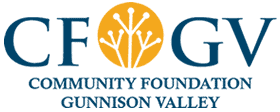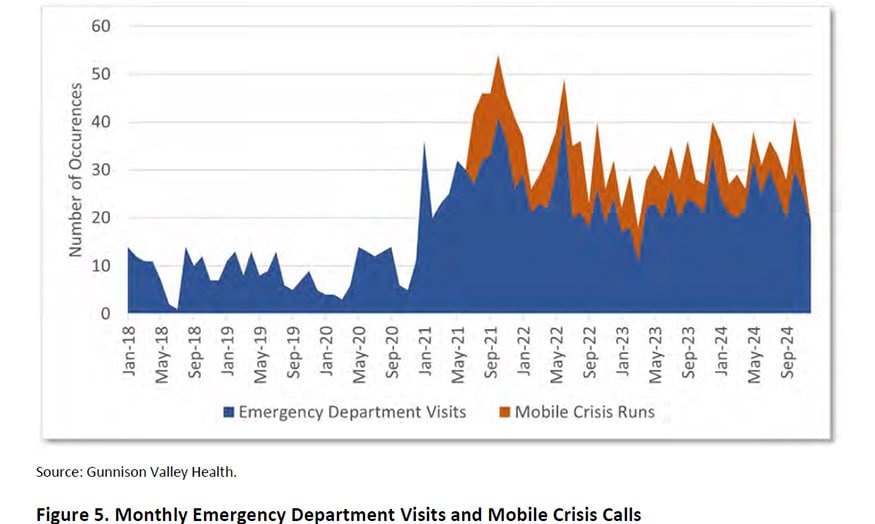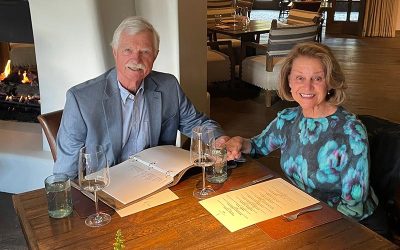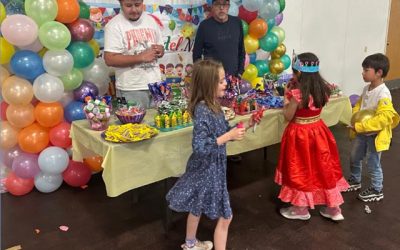How is Gunnison County doing?
In 2022, the Gunnison County Community Health Coalition (CHC) put out a report called the 2022 State of the Community Report (2022 Report). At the time, we spent several months covering different aspects of the 200+ page report because the findings struck us as being so alarming.
The report was both frightening and galvanizing for our community. At times the challenges seemed insurmountable. But the CHC and a wide range of organizations across the community came together to work towards lasting change. The public sector, generous donors, CFGV, and other foundations have all invested in significant ways, guided by the 2022 Report.
A 2025 Update
In 2024, CFGV received a grant from Vail Resorts EpicPromise to complete a streamlined update to the 2022 Report. Jeff Moffett of Triple Point Strategic Consulting, John Powell of Gunnison County, and Cole Cooper of Western Colorado University and Desert Spring Health Consulting worked together on the Gunnison County State of the Community 2025 Report (2025 Update).
Tasked with focusing on key metrics from the 2022 Report, the research team looked at updated data from the last few years as well as 130+ responses to a survey and over thirty interviews with community members. While we recommend reading the report in full (it’s only 20 pages this time!), we also want to provide some commentary on the pieces in the report that most stood out to the CFGV team.
An Update on Self-Sufficiency
The concept of self-sufficiency was a key point in the original 2022 Report. It’s a measure from the Center for Women’s Welfare at the University of Washington that captures the cost of living for working families at a “minimally adequate level.” The Center for Women’s Welfare provides detailed charts for different family compositions by county, allowing our research team to estimate the percentage of community members who live below the self-sufficiency standard.
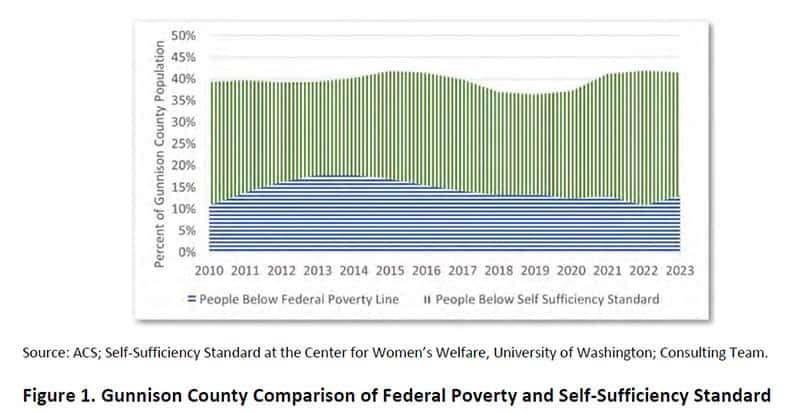
The team estimated between 31 and 44 percent of community members lived below the self-sufficiency standard in the 2022 Report. The 2025 Update estimates it to now be 41 percent. The percentage of our community living below the poverty line has remained relatively steady at around 13%, leaving a huge gap between people eligible for federal support and people who earn enough money to cover basic expenses. More than a third of community members are making hard choices every day or leaning on community support (nonprofits, county programs, etc.) to simply meet their basic needs. Our nonprofit sector and the generous donors who support the sector through philanthropy are critical to supporting the workforce and their families who see expenses add up faster than income each month.
Affordable Housing, or the Lack of It
Over the last decade, community members have largely agreed that the lack of affordable housing threatens our way of life in this community. There are not enough places for people working in the Gunnison Valley to live and it’s very hard to put down roots and raise a family here. High housing costs are a huge contributor to the high percentage of people living below self-sufficiency. It negatively impacts mental health. More and more people are relocating, either from the north end of the valley to the south end or even to other communities.
The One Valley Resiliency Roadmap (which we cover here) put a big emphasis on housing. The tangible results we’re starting to see from that collaboration, such as the Sawtooth and Whetstone developments, are going to make a dent in the problem. However, the research team for the 2025 Update estimated the cost of meeting the workforce housing needs to be just over $500 million over the next ten years. At the same time, they also acknowledged that even if we could just build our way out of the housing shortage, we face additional challenges around transportation, infrastructure, and critical community services. Change is constant and how we navigate tough conversations and unavoidable tradeoffs is key to steering change.
Behavioral Health
Behavioral health was the primary focus of the 2022 Report. The research team defined behavioral health as mental health issues (suicidal ideation, anxiety, depression, etc.) and substance-use issues (overdose, intoxication, withdrawal, etc.) for the purposes of this update. While they found that emergency department visits due to behavioral health have remained relatively steady over the last few years, they noted that the Mobile Crisis Unit at Gunnison Valley Health (GVH) has increased the hospital system’s ability to support individuals before they reach the emergency department. When you combine mobile crisis unit and emergency department, the number of people using behavioral health services through GVH has increased.
The research team used survey responses and interviews to link the behavioral health outcomes we are seeing to the high percentage of people living below self-sufficiency. People who don’t know how they’re going to pay all their bills every month are dealing with economic stressors that contribute to poor behavioral health. GVH has implemented programs to address behavioral health crises, and many people are working to address the upstream causes of poor behavioral health outcomes, but these types of interventions take time to deliver results.
Where do we go from here?
It’s disheartening to compare this 2025 Update to the 2022 Report and not see improvements in terms of the numbers. In some cases, the numbers look even worse than they were a few years ago. That’s disappointing, but it doesn’t mean we’re not starting to see shifts.
The One Valley Leadership Council has existed in some form in Gunnison County for over a decade now. Participating organizations have cultivated a spirit of collaboration across the Gunnison Valley. Without that spirit of collaboration, it’s possible that the early disagreements between the town and the County regarding the Whetstone development would have stopped that project in its tracks. Instead, the debates that took place over the course of last spring as they worked through that process have made the project stronger than it otherwise would have been.
The research team highlights a handful of other successes, both locally and in other communities including efforts by Western Colorado University, GVH, Gunnison Sanctuary Housing, and others. We encourage you to take a look and see what already has been done. Perhaps there is a way for you or your organization to join an existing effort or launch something new. It reminds us of the Edward Everett Hale quote:
I am only one, but I am one. I cannot do everything, but I can do something. And because I cannot do everything, I will not refuse to do the something that I can do.
None of us can meet every challenge our community faces alone. But not being able to fix everything is a poor reason not to try to fix something. This is a time for each of us to come together and work on whatever cause captures your heart.
We celebrate the people who have stepped up since the original 2022 Report. Your work has value on both a human and a community scale. CFGV is here to stand by you, collaborate with you, and dream up creative ways to cultivate the resilient Gunnison Valley we all hope to see.
Simplified Summary
The Gunnison Valley in Colorado is facing some big challenges. In 2022, a report showed many problems in the community. Now in 2025, they’ve made a shorter update report to see if things have improved.
Here’s what the new report found:
- Many people in Gunnison Valley (about 41%) don’t make enough money to cover their basic needs.
- Housing is very expensive, making it hard for workers to live there.
- Mental health problems and substance use issues remain a big concern.
- The community needs about $500 million over ten years to build enough housing for workers.
Even though the numbers don’t show much improvement yet, community groups are working together to solve these problems. Some examples of progress include:
- New housing developments called Sawtooth and Whetstone
- A Mobile Crisis Unit at the hospital to help people with mental health emergencies
- Western Colorado University and other organizations starting helpful programs
The report reminds everyone that while no single person can fix all these problems, everyone can help with something. It encourages people to work together to make Gunnison Valley stronger and healthier.
